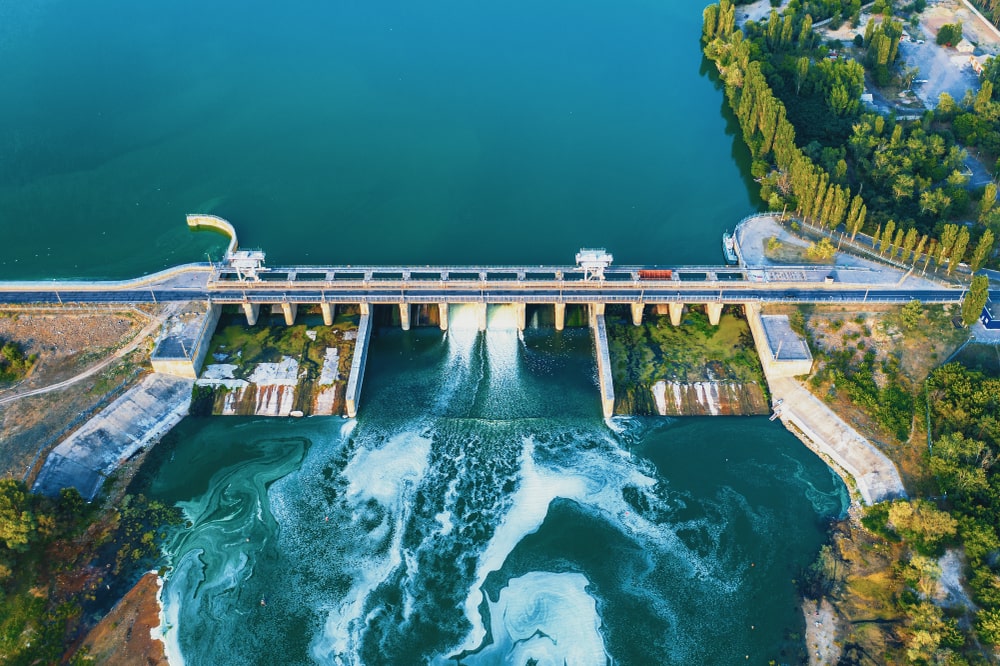Home > Energy Plans > Hydroelectricity
Hydroelectricity
All your questions about hydroelectricity in Australia answered here by Savvy
Author
Savvy Editorial TeamFact checked

How does hydroelectric power work? What are the advantages of hydroelectric energy? If you’ve ever wondered about these questions, and want to know all about hydroelectricity in Australia, read on!
How does hydroelectric power work?
Hydroelectric power harnesses the energy of flowing or falling water to generate electricity. Here's a simplified explanation of how it works. The process involves several key steps:
Water storage:
A dam is built across a river to create a reservoir or a vast body of water. The dam helps in controlling the flow of water and stores potential energy.
Water release:
When electricity generation is required, gates or valves in the dam are opened to release a controlled amount of water from the reservoir. The released water flows through tunnels called penstocks, which are large pipes that direct the water towards the turbine.
Turbine activation:
As the water rushes through the penstocks, it strikes the blades of a turbine, causing the turbine to spin. The turbine is typically a large, wheel-like device with curved blades.
Electricity generation:
The spinning turbine is connected to a generator. Inside the generator there is a rotor, which is a large electromagnet that rotates within a set of stationary coils called stators. As the rotor spins, it creates a magnetic field that induces an electrical current in the stator coils, generating the electricity that we use.
Power distribution:
The electricity generated by the generator is sent through power lines to homes, businesses, and industries. Transformers increase the voltage of the electricity for efficient transmission over long distances, and then local transformers step down the voltage for safe use in households and businesses.
Water return:
After passing through the turbine, the water is released back into the river downstream of the dam. This ensures that the water cycle continues and minimises the impact on natural ecosystems.
Hydroelectric power plants can range in size from small-scale installations to large, multi-megawatt projects. The amount of electricity generated depends on the volume of water flow and the height from which it falls (known as the head). The greater the volume and height, the more potential energy is available to generate electricity.
The process of hydroelectric power generation is highly efficient and offers a reliable, renewable source of electricity with minimal greenhouse gas emissions. It plays a highly significant role in global energy production.
Over the last 20 years, hydropower’s total capacity rose 70% globally, according to the International Energy Agency. It now accounts for just over 17% of global renewable energy generation, more than all other renewable sources of energy combined.
What are the advantages and disadvantages of hydroelectric energy?
Advantages of hydroelectric energy:
Hydroelectricity has many advantages over other sources of energy generation, such as coal or oil. These include:
- Renewable and clean: Hydroelectric power relies on the water cycle, making it a renewable energy source. It produces minimal greenhouse gas emissions, reducing air pollution compared to fossil fuels.
- Potential for large-scale power generation: Hydroelectric plants can generate a significant amount of electricity, providing a reliable and consistent power supply to meet high energy demands.
- Quickly powered up or shut down: Unlike other types of electricity generators, such as nuclear or coal-fired power stations, hydroelectric systems can quickly be powered up or down and so can react to fluctuating power demands or weather patters.
- Water management: Hydroelectric facilities contribute to water management by regulating water levels and controlling floods.
- Long lifespan: Hydroelectric plants have long lifespans, typically lasting 50 to 100 years or more, providing a stable and sustainable energy source.
Disadvantages of hydroelectric energy:
However, there are also some disadvantages to hydroelectric generation systems. These include:
- Environmental impact: The construction of dams and reservoirs can result in habitat disruption, alteration of river ecosystems, and the displacement of wildlife and communities.
- Land and ecosystem loss: Hydroelectric projects often require large areas of land, leading to the flooding of valleys and loss of natural habitats.
- Upfront costs: Building hydroelectric infrastructure involves significant upfront investment, making it financially challenging for some regions.
- Limited suitable locations: Not all areas have the geographic characteristics necessary for constructing large-scale hydroelectric plants, limiting widespread adoption.
- Reliance on water availability: Hydroelectric power generation is dependent on water availability, which can fluctuate due to droughts or changes in rain patterns.
While hydroelectric energy offers many benefits as a renewable energy source, it is important to consider its environmental and economic implications when evaluating its overall sustainability.
What’s the future for hydroelectric energy in Australia?
The future for hydroelectric energy in Australia holds both opportunities and challenges. Here are some key aspects to consider:
- Existing hydroelectric infrastructure: Australia already has several large-scale hydroelectric power stations, such as the Snowy Mountains Scheme. These facilities contribute significantly to the country's electricity generation and will continue to play a crucial role in the future.
- Expansion of pumped hydro storage: Pumped hydro storage is gaining attention as a means of storing excess renewable energy and ensuring grid stability. Hydro storage basically involves pumping water back up from a lower to a higher reservoir when wind or solar energy is plentiful, and then allowing it to flow downhill again to generate electricity when wind or solar energy generation is low. Projects like the Snowy 2.0 expansion aim to enhance Australia's energy storage capacity and enable greater integration of intermittent renewable sources.
- Small-scale and micro hydro systems: There is potential for the development of small-scale hydroelectric systems, particularly in rural and remote areas with suitable water resources. These systems can provide localised power generation, reducing dependence on fossil fuels and enhancing energy self-sufficiency.
- Environmental considerations: The environmental impacts of large-scale hydroelectric projects, including habitat disruption and alteration of river ecosystems, have led to increased scrutiny of the hydroelectricity industry. Future developments must balance energy needs with environmental conservation, emphasising sustainable practices and minimising ecological harm.
- Integration with other renewables: Hydroelectric power can complement other renewable energy sources, such as solar and wind, to create a diverse and resilient energy mix. Integrated energy systems that combine different renewables can help enhance overall grid stability.
- Research and innovation: Ongoing research and technological advancements in areas like turbine efficiency, fish passage solutions, and environmental mitigation strategies will contribute to the future of hydroelectric energy in Australia. These innovations aim to improve the sustainability, efficiency, and environmental performance of hydroelectric projects.
While hydroelectric energy will likely continue to be an important part of Australia's energy portfolio, future developments must prioritise sustainable practices, address environmental concerns, and explore innovative solutions to ensure a balanced and renewable energy future.
Helpful energy guides
Compare energy plans
Disclaimer:
Savvy is partnered with Econnex Comparison (CIMET Sales Pty Ltd, ABN 72 620 395 726) to provide readers with a variety of energy plans to compare. We do not compare all retailers in the market, or all plans offered by all retailers. Savvy earns a commission from Econnex each time a customer buys an energy plan via our website. We don’t arrange for products to be purchased directly, as all purchases are conducted via Econnex.
Any advice presented above is general in nature and doesn’t consider your personal or business objectives, needs or finances. It’s always important to consider whether advice is suitable for you before purchasing an energy plan. For further information on the variety of energy plans compared by Econnex, or how their business works, you can visit their website.










